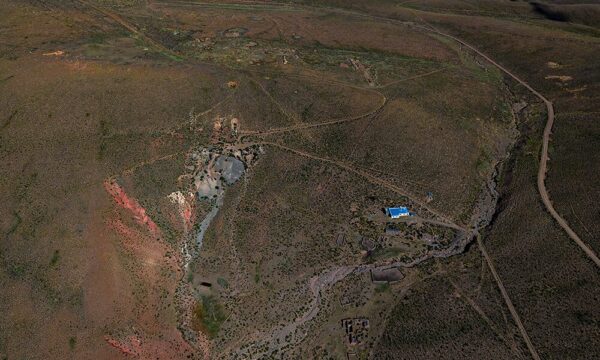While developing Tulu Kapi remains KEFI’s immediate priority, there are a number of exploration prospects that provide potential for the incremental and marginal expansion of KEFI’s gold output in the future.
Two of the potential areas of expansion are at Tulu Kapi itself.
Prior exploration drilling by Nyota has already extended the limits of mineralisation by up to 4km to the west of the Tulu Kapi pit. At 1.3-1.5g/t in-situ, the grade of this mineralisation was too low to be included in the development plan for the mine. However, its width (typically 10-14m wide) and oxide nature potentially qualify it as the basis of an incremental heap leach operation. To this end, 24-hour, coarse crush (>6mm), cyanide leach bottle roll metallurgical tests (a proxy for column leach tests) have been completed on selected trench samples and demonstrate a recovery of c 94%. Management estimates that resources containing 100-200koz of gold could be amenable to exploitation by such methods and could therefore support an operation producing 10-20koz gold pa for approximately 10 years.
In addition to a potential heap leach operation, c 300koz of resources exist at depth at Tulu Kapi in the indicated and inferred categories at grades of approximately 6g/t. These resources are ‘open’ down plunge. In this case, the higher grade could be attributed to either a tighter structure or a hotter environment on formation. Nevertheless, the widths of the structures typically exceed 4m and are therefore amenable to underground mining. Moreover, the higher grades contribute to higher metallurgical recoveries, typically in the range 93-94%.
While developments are obviously still at an early stage, a preliminary mine plan envisages an incremental, high-grade underground mining operation at Tulu Kapi, processing 320,000t of ore per year to produce 40-50koz recovered gold pa to complement the initial open-pit mining plan.
The Arabian side of the Arabian-Nubian Shield (ANS) is the source of some of man’s earliest known mining activities, including the Mahd adh Dhahab (‘Cradle of Gold’) mine, which is the leading gold mining area in the Arabian peninsula, in the Al Madina province of the Hejaz region of Saudi Arabia, between Mecca and Medina. Gold was first mined in the area around 5,000 years ago in the form of swarms of gold-bearing quartz veins and the site has been identified as one of the possible locations of King Solomon’s mines, where archaeologists have found a large abandoned gold mine, c 1Mt of waste rock and thousands of ancient stone hammers and grindstones. Inter alia, the area inspired the earliest-known map, the Turin Papyrus, which the Egyptians used to mine gold in Egypt and north-east Sudan.
In general, the ANS consists of Precambrian crystalline rocks and hosts various minerals in a diverse range of deposit formations, including gold, copper, zinc, tantalum, silver, and potash, which can be found in mesothermal gold, polymetallic, quartz vein gold and volcanogenic massive sulphide (VMS) ores.
KEFI currently has a 40% interest in a 733koz resource at Jibal Qutman on the Arabian side of the ANS. In our August initiation report, we estimated that Jibal Qutman would be worth US$4.5m, or 0.17p per share to KEFI, if valued at the average of its London peers, given its resource categorisations (with self-evident upside potential in the event of additional, future development). At the average global cost of discovery of its resources, it would be worth US$2.8, or 0.10p per share.
The Saudi Arabian government has stated that it wishes to grow the mining sector materially in the foreseeable future. Where before all activity was conducted by the state-controlled Saudi Arabian Mining Company (Ma’aden), it has now been de-regulated and opened up to overseas investors (eg Barrick, among others), although Ma’aden remains the largest operator, with five gold mines currently in production and a further five planned.
Unlike many other jurisdictions, no royalties are levied on production in Saudi Arabia. Moreover, a requirement to demonstrate advance funds to underwrite future works (a requirement managed by ARTAR for G&M, see below) acts as an effective barrier to entry for the more opportunistic junior explorers. On the other hand, up to 75% of the capital costs of strategic projects (eg the first privately-funded gold mine) are eligible for Saudi Industrial Development Fund (SIDF) debt funding at minimal rates of interest (eg below 2%), which would leave KEFI (or any other company) needing to fund only 40% of 25% of the total capital cost of the project to maintain its interest. In the meantime, KEFI states that the cost of exploration in Saudi Arabia is close to US$40 per metre of reverse circulation (RC) drilling and US$100/m of diamond drilling (cf c US$160/m in Ethiopia).
KEFI’s interest in Saudi Arabia began with the formation of a 40:60 joint venture, called Gold & Minerals, with the Saudi construction and investment group ARTAR (the vehicle of the Al-Rashid family). Despite its ‘junior’ financial interest, KEFI nevertheless operates all G&M’s assets in Saudi Arabia, while ARTAR provides administrative, logistic and professional services advice.
The US Geological Survey and the French BRGM have jointly compiled approximately 60 years’ worth of geological data on Saudi Arabia. In total, they documented over 5,000 historic mining sites in the country. Although this information is not typically generally available, it has been made available to KEFI, which has subsequently made 24 licence applications over areas with old workings and begun early-stage trenching programmes.
Jibal Qutman is in the central southern region of Saudi Arabia, on the Nabitah-Tathlith fault zone of the Arabian-Nubian Shield (a 300km-long structure with multiple outcrops at surface) and along which BRGM mapped over 40 mineral occurrences. KEFI’s management likens the area to Western Australia and, in particular, Kalgoorlie before it was pegged, but without the attendant problems of a settled population and private land ownership. Gold mineralisation at Jibal Qutman itself is hosted in a series of quartz veins in six separate ore bodies, denoted the Main Zone, the South Zone, the West Zone, 3K Hill, 5K Hill and Pyrite Hill. The main vein dips to the east at an angle of c 45, surrounded by parallel veins that form stringer zones around it.
An infill drill programme on 25m centres began in late June 2015, comprising 5,415m of reverse circulation (RC) drilling on five of Jibal Qutman’s six mineralised zones, with the aim of converting resources from the inferred into the indicated category and also adding additional oxide material via the drilling of zones proximal to the proposed pits. Column leach metallurgical tests on the oxide portion of the resource have indicated gold recoveries of c 73%, as a result of which KEFI envisages developing the area via a string of pits mining oxidised material for heap leach processing. To this end, it is preparing a mining licence application at Jibal Qutman (for which a maiden reserve statement will be required) and trying to fast track a further four licences. Management estimates that approximately 200koz of Jibal Qutman’s 290koz oxide resource will form the basis of the first open pit, supporting an operation producing c 30-40koz on average per year over the life of the initial mine at a metallurgical recovery rate of c 73%. Cash operating costs on the initial resource are similarly estimated at US$600/oz (putting it in the lowest cost tercile of global gold production), while capex is estimated at US$30m. In due course, the addition of four other mining licences could support a proportionally larger production base using a modular development model. Ideally, management would like pre-production preparation to be completed by the end of CY16, such that construction and development crews at Tulu Kapi could then be seamlessly transferred from Ethiopia to Saudi Arabia in FY17.
Hawiah (copper and base metals)
Seven of KEFI’s 24 licences are on the 120km Mamilah-Wadi Bidah Volcanogenic Mineral belt. BRGM and the USGS documented c 30 VMS deposits in the region, historically, of which at least one was subsequently drilled and found to contain copper at a grade in excess of 2%.
KEFI’s Hawiah deposit is on a 6km gold mineralised gossan and is interpreted to overlie a copper-gold-zinc massive sulphide target. An initial 53-trench surface sampling programme over a 6km horizon demonstrated early evidence for the presence of metals in the form of visible staining. As a result, a major geophysical survey was conducted over the southern half of the gossanous horizon, which identified a large geophysical anomaly (approximately 2,000m long and 300m high) also potentially indicating the presence of metals. Although the modular development of near-surface gold oxide deposits will be KEFI’s immediate (chronological) priority in Saudi Arabia therefore, the potential scale of a VMS at Hawiah has made it a priority exploration and commercial focus for KEFI in H215 and CY16, with copper the main target.
Hitherto, a significant constraint to the developing mining industry in Saudi Arabia has been a lack of access to water. However, Ma’aden has now commissioned a 430km, 18-inch pipeline to carry treated waste water to the Taif Makkah Region. Management believes that water is also potentially available via artesian sources or via trucking (note, there is a precedent for trucking water in Saudi Arabia, where fuel costs as low as US$0.09 per litre make this almost uniquely feasible).
In addition to cheap trucking costs, the low cost of fuel also results in a low power cost of c 2-3 US cents per kWh for generated electricity. This means that the development of KEFI’s Saudi Arabian assets will result in its operating in very low-cost jurisdictions with respect to power and labour, in particular, on both sides of the Red Sea, and thereby allow it to maintain total cash costs in the lower half of the global cost curve.
















